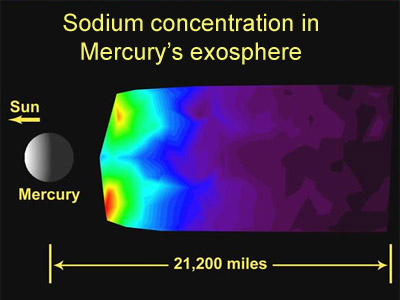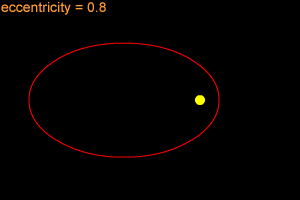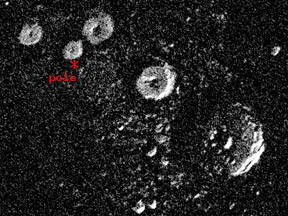Mercury Statistics
| Planetary Symbol: |
 |
Name in Roman/Greek Mythology: |
Mercury/Hermes |
| Diameter: |
4,878 km (3,030 miles) |
Rotation Period about Axis: |
58.65 days |
| Mass: |
0.33x10^24 kilograms (0.06 x Earth's) |
Revolution Period about the Sun: |
0.24 years |
| Density: |
5,427 kg/m^3 |
Tilt of Axis: |
0o |
| Minimum Distance from Sun: |
46.0 million km
(28.6 million miles) |
Surface Gravity: |
3.7 m/s^2 (0.38 x Earth's) |
| Maximum Distance from Sun: |
69.8 million km
(43.4 million miles) |
Temperature Range on Mercury: |
-184o C to 427o C
(-300o F to 800o F) |
| Orbital Semimajor Axis: |
0.387 AU (Earth=1 AU) |
Average Surface Temperature (K): |
440K |
| Minimum Distance from Earth: |
77.3 million km
(48.0 million miles) |
Satellites: |
0 |
 Mercury Image Archive
Mercury Image Archive
 Comparative Planetary Statistics -- in table form
Comparative Planetary Statistics -- in table form
 Comparative Orbital Statistics -- in table form
Comparative Orbital Statistics -- in table form
 Actual Distance to Earth
Actual Distance to Earth
You might also be interested in:

Mercury has very little atmosphere. The planet's small size means that its gravity is too weak to hold down a normal atmosphere. There is a very thin atmosphere around the planet. Mercury's thin atmosphere
...more
Most objects in orbits move along an elliptical path. An ellipse is a shape that can be thought of as a "stretched out" circle or an oval. An ellipse can be very long and thin, or it can be quite
...more
If Uranus is the "tilted planet", Mercury might be called the "upright planet". The spin axis of Uranus, which defines the locations of the planet's North and South Poles, is tilted by 98°. The spin axis
...more
Mercury has a weak magnetic field. Like Earth's magnetic field, Mercury's dipole field is tilted with respect to the planet's spin axis. This means that Mercury's magnetic poles and its geographic poles
...more
Mercury is the only terrestrial planet other than the Earth that has a significant magnetic field (220 nT). This field, along with the planet's high density and small size relative to the Earth, indicates
...more

 Comparative Planetary Statistics -- in table form
Comparative Planetary Statistics -- in table form
 Comparative Orbital Statistics -- in table form
Comparative Orbital Statistics -- in table form


 Mercury Image Archive
Mercury Image Archive








